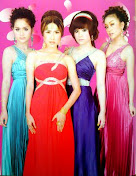

Photo by: Borei Sylyvann
Student Sreng Vanny has her say using the Khmer version of sign language.
--------------------------------------------------------------------------------
They should not speak ill of people…even though I cannot hear, I can see.
--------------------------------------------------------------------------------
A unique Khmer sign language course derived from its American equivalent helps students at a school for the mute and deaf to complete their studies
The students run with an abandon befitting their age, and the usual playground high jinks can be seen in every corner of the recreation area.
Yet there is a crucial difference between this childhood scene and those witnessed in schools all over the world: the silence.
Hardly a noise is heard here at Chhbar Ampov, a specialist school for the mute and deaf, where the preferred method of communication is a pioneering sign language interpretable by Cambodians.
The students have a new lease on life since they learned the methods endorsed by Krou Sar Thmey, an organisation that helped provided the country’s first school and language course for the deaf and mute.
The Khmer sign language course has roots in its American equivalent, with some crucial tweaks to make it accessible to Cambodians.
“We took parts of the American language, but changed them to fit a Cambodian context,” explained Cheam Kosal, a general director of Krou Sar Thmey. “We also left in some natural signs used by deaf and mute people.”
The development of the language has resulted in the production of two dictionaries, which Cambodians can use to look up more than 1,600 words in sign language. The reference books are available on CD-ROM and online.
Khmer textbooks used by first- to fifth-grade students have also been redesigned, with images of hand signals included, to cater specifically to mute and deaf learners.
“It is a great aid in training teachers to practise and learn the language effectively,” said Hout Virak, a 27-year-old physics and chemistry teacher at Chhbar Ampov.
“At first, I felt quite nervous about teaching or explaining things to the students, but now it’s pretty easy since I always have a quiet group, unlike some of my other rowdy classes.”
Students divide their time between Chhbar Ampov and regular school, and some recently passed the general high school exam.
Sreng Vanny, one of those talented learners, told of her joy at her achievement through translator Hout Virak.
“I am very happy to have passed the exam,” she expressed in sign language, with a beaming smile, to her teacher.
“It was really hard to communicate with others and to ask the teacher questions when they didn’t know our language,” she added. “But I tried very hard, and now I have a good result.”
The sign language dictionary is proving helpful in Sreng Vanny’s home life as well. Her father Por Sreng said it was a useful aid in conversing with his daughter.
“I can understand some words used in the sign language,” he said. “I am happy to try to combine it with communicating with her via writing.”
But there have been occasions when the new language has been misunderstood. Hout Virak recalls students who once attempted to sign that they were dirty, by dragging their hands across their necks. The teacher, unfamiliar with the language, misinterpreted it, believing they wanted to kill her.
Despite the huge strides in learning and communication, the students still face an uphill battle. Marginalisation and stigma still afflict the deaf and mute population of Cambodia, as Sreng Vanny laments.
“I can see people gossiping about me,” she said.











0 comments:
Post a Comment